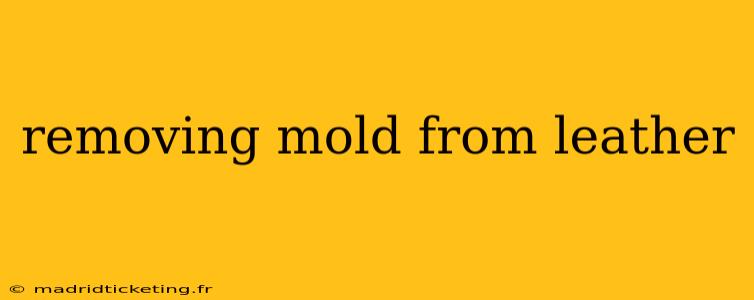Mold on leather is an unwelcome sight, often resulting from dampness or improper storage. Luckily, with the right approach, you can often restore your leather goods to their former glory. This guide details how to effectively remove mold from leather, addressing common concerns and providing preventative measures.
What Causes Mold on Leather?
Mold thrives in damp, dark environments. Leather, being a porous material, is particularly susceptible. Several factors contribute to mold growth on leather:
- High Humidity: Excess moisture in the air creates the perfect breeding ground for mold spores.
- Lack of Air Circulation: Poor ventilation traps moisture, promoting mold growth.
- Water Damage: Spills, leaks, or even prolonged exposure to rain can saturate leather, leading to mold.
- Improper Storage: Storing leather goods in airtight containers or damp places increases the risk of mold.
How to Remove Mold from Leather: A Step-by-Step Process
The method for removing mold from leather depends on the severity of the infestation. For minor mold growth, a gentle cleaning might suffice. However, for extensive mold, professional cleaning might be necessary.
1. Preparation is Key:
- Assess the Damage: Before you begin, carefully examine the affected area. Determine the extent of the mold growth to decide on the best course of action.
- Safety First: Wear gloves and a mask to protect yourself from mold spores. Work in a well-ventilated area.
2. Cleaning Mild Mold:
- Gentle Cleaning: For surface mold, mix a mild solution of dish soap and lukewarm water. Using a soft cloth or sponge, gently blot (do not rub) the affected area. Excess rubbing can damage the leather.
- Rinse and Dry: Rinse the area with clean water and blot dry with a clean, absorbent cloth. Allow the leather to air dry completely in a well-ventilated area, away from direct sunlight or heat.
3. Treating Moderate to Severe Mold:
- Isopropyl Alcohol (70%): For more stubborn mold, you can use isopropyl alcohol. Apply it sparingly with a cotton swab or soft cloth, focusing on the moldy areas. Always test a hidden area first to ensure it doesn't damage the leather's finish.
- Commercial Leather Cleaner: Use a commercial leather cleaner specifically designed for mold removal. Follow the manufacturer's instructions carefully.
- Professional Cleaning: For extensive or deeply embedded mold, it’s best to consult a professional leather cleaner.
4. Post-Cleaning Care:
- Conditioning: Once the leather is completely dry, apply a leather conditioner to restore its suppleness and protect it from future damage.
- Prevention: Store your leather goods in a cool, dry, and well-ventilated area. Use breathable storage bags or containers to prevent moisture buildup.
What if the Mold is on Suede or Nubuck Leather?
Suede and nubuck leather are more delicate than smooth leather and require a gentler approach. Use a specialized suede cleaner and brush to remove surface mold. Avoid excessive scrubbing, as this can damage the nap of the material. Professional cleaning is often recommended for these types of leather.
Can Vinegar Remove Mold from Leather?
While vinegar is effective against mold on some surfaces, it's not recommended for leather. The acidity of vinegar can damage the leather, potentially causing discoloration or drying. Stick to the gentle cleaning methods outlined above.
How Can I Prevent Mold on Leather?
Prevention is always better than cure! Here are some tips to keep mold away from your leather goods:
- Regular Cleaning: Regularly wipe down leather items with a damp cloth to remove dust and dirt.
- Proper Storage: Store leather goods in a cool, dry, and well-ventilated area.
- Moisture Control: Use a dehumidifier in damp areas to control humidity levels.
- Immediate Attention: Address any spills or water damage promptly to prevent mold growth.
By following these steps and employing preventative measures, you can effectively remove mold from your leather items and keep them looking their best for years to come. Remember that patience and a gentle touch are crucial when dealing with delicate leather goods. If in doubt, consult a professional leather cleaner.

